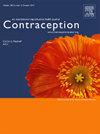阴道避孕NuvaRing@减少子宫腺肌症的症状和子宫特征。前瞻性评价。
IF 2.3
2区 医学
Q1 OBSTETRICS & GYNECOLOGY
引用次数: 0
摘要
目的:我们旨在评估NuvaRing@避孕对子宫腺肌症妇女超声体征和症状的影响。研究设计:我们进行了一项前瞻性自我控制观察性研究,研究对象是需要使用NuvaRing@.避孕的子宫腺肌症女性排除标准为实际使用或激素避孕禁忌症。NuvaRing@是连续用药,每三周一环,没有无激素间隔,以避免月经。临床表现提示子宫腺肌症,超声检查证实。使用NuvaRing@ 6个月前后,我们采用10厘米视觉模拟评分(VAS)评估子宫体积、子宫腺肌症的直接和间接超声体征以及月经、月经间疼痛和性交疼痛的严重程度。结果:本研究纳入42名女性,年龄30.0±4.5岁,BMI为22.8±1.8 kg/m²。除一人外,所有人都没有生育。使用NuvaRing@ 6个月后,子宫体积减少14.4 ± 13.5% (p=0.001)。在6名停止产糖的妇女中也观察到类似的下降。每位患者的直接超声征象(总征象/n名女性)从0.5(范围0-3)降至0.08(范围0-2)(p=0.003),间接征象从2.8(范围1-5)降至1.5(范围0-5)(p=0.001)。月经疼痛的血管从8.3下降 ± 1.2到3.9 ± 2.5 (p = 0.001), intermenstrual疼痛从6.6 ± 1.4到2.9 ± 1.7 (p = 0.001),以及性交疼痛从7.0 ± 1.4到2.9 ± 1.7 (p = 0.001)。月经疼痛的减轻与子宫体积的减小有显著的相关性(p=0.003)。结论:我们的研究结果表明,NuvaRing@is避孕对子宫腺肌症妇女是一种可行的避孕选择。结论:对于患有子宫腺肌症的女性,NuvaRing@是有用的,因为它可以减少子宫腺肌症的临床症状和子宫超声特征。本文章由计算机程序翻译,如有差异,请以英文原文为准。
Vaginal contraception with NuvaRing decreases symptoms and uterine features of adenomyosis: A prospective evaluation
Objective
We aimed to assess the effects of contraception with NuvaRing on ultrasound signs and symptoms of women with adenomyosis.
Study design
We conducted a prospective self-controlled observational study on women with adenomyosis who required contraception with NuvaRing. Exclusion criteria were actual use or contraindications to hormonal contraception. NuvaRing was administered in a continuous regimen, one ring every 3 weeks without hormone-free intervals, to avoid menses. Adenomyosis, suggested by clinical signs, was confirmed by ultrasonography. Before and after 6 months of NuvaRing, we evaluated uterine volume, direct and indirect ultrasound signs of adenomyosis, and the severity of menstrual, intermenstrual pain, and pain during intercourse, by a 10-cm visual analog scale (VAS).
Result(s)
This study included 42 women, 30.0 ± 4.5 years old, with a BMI of 22.8 ± 1.8 kg/m². All were nulliparous except one. Following 6 months of NuvaRing, uterine volume decreased of 14.4 ± 13.5% (p = 0.001). A similar decrease was observed in six women switching from dienogest. Direct ultrasound signs of adenomyosis per patient (total signs/n women) decreased from 0.5 (range 0–3) to 0.08 (range 0–2) (p = 0.003), and indirect signs, from 2.8 (range 1–5) to 1.5 (range 0–5) (p = 0.001). The VAS for menstrual pain decreased from 8.3 ± 1.2 to 3.9 ± 2.5 (p = 0.001), for intermenstrual pain from 6.6 ± 1.4 to 2.9 ± 1.7 (p = 0.001), and for pain during intercourse from 7.0 ± 1.4 to 2.9 ± 1.7 (p = 0.001). The decrease of menstrual pain was significantly associated with the reduction of uterine volume (p = 0.003).
Conclusion(s)
Our findings demonstrate that contraception with NuvaRing is a viable contraceptive option for women with adenomyosis.
Implications
In women with adenomyosis contraception with NuvaRing is useful and can be proposed because it reduces the clinical signs and the uterine ultrasound features of adenomyosis.
求助全文
通过发布文献求助,成功后即可免费获取论文全文。
去求助
来源期刊

Contraception
医学-妇产科学
CiteScore
4.70
自引率
17.20%
发文量
211
审稿时长
69 days
期刊介绍:
Contraception has an open access mirror journal Contraception: X, sharing the same aims and scope, editorial team, submission system and rigorous peer review.
The journal Contraception wishes to advance reproductive health through the rapid publication of the best and most interesting new scholarship regarding contraception and related fields such as abortion. The journal welcomes manuscripts from investigators working in the laboratory, clinical and social sciences, as well as public health and health professions education.
 求助内容:
求助内容: 应助结果提醒方式:
应助结果提醒方式:


